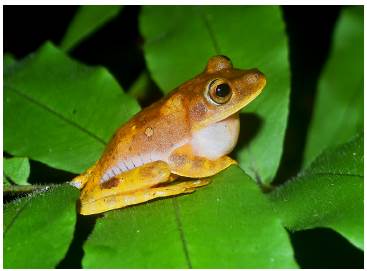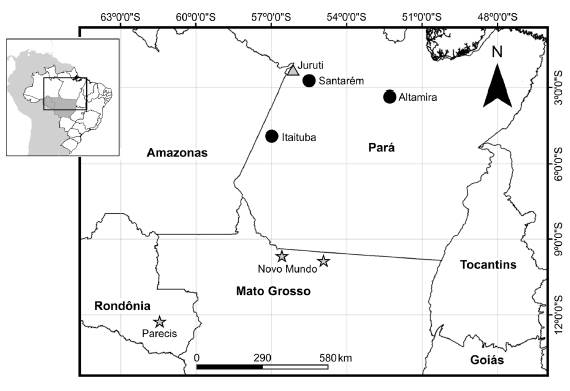The Neotropical genus Boana Gray, 1825 is currently represented by 93 valid species and is widely distributed from Nicaragua to Argentina, throughout most of South America (Frost c2018). These amphibian species are known as gladiator frogs and are divided in seven species groups: Boana albopunctata (Spix, 1824), Boana benitezi (Rivero, 1961), Boana faber (Wied-Neuwied, 1821), Boana pellucens (Werner, 1901), Boana pulchella (Duméril and Bibron, 1841), Boana punctata (Schneider, 1799), and Boana semilineata (Spix, 1824) (Faivovich et al. 2005). Belonging to the B. semilineata species group, Boana icamiaba is a recently described Amazonian anuran species from the state of Pará, northern Brazil (Peloso et al. 2018).
Our study provides the first records of Boana icamiaba for the states of Mato Grosso and Rondônia, Brazil. In Mato Grosso, numbering eight adult males of B. icamiaba (Fig. 1) were collected at the Parque Estadual do Cristalino - municipality of Novo Mundo, state of Mato Grosso. Five male specimens were collected on 10th Jun, 2012 (9°47' South, 55° 86' West) and three on 28th Feb, 2018 (9°49' South, 55°15' West). All specimens were found calling inside riparian forests in stream margins. The collected voucher specimens were anesthetized with 2 % lidocaine, fixed in 10 % formalin, and preserved in 70 % ethanol to be stored at the Herpetological Collection of the Acervo Biológico da Amazônia Meridional - ABAM (ABAM-H 1461-1465, ABAM-H 3757-3759) of the Universidade Federal de Mato Grosso, Campus Universitário de Sinop, Mato Grosso state.

Figure 1 Specimen of Boana icamiaba collected at Parque Estadual do Cristalino, municipality of Novo Mundo, Mato Grosso state, Brazil.
The collected specimens of B. icamiaba are in total accordance with the original description of Peloso et al. (2018). The main characters that distinguish B. icamiaba from all species in the B. geographica-semilineata clade are: (1) presence of a prepollex developed into a spine, which is absent in the species of the B. geographica-semilineata clade; and (2) absence of nuptial pads, which is present in the species of the B. geographica-semilineata clade. Additional morphological and bioacoustic comparisons between B. icamiaba and named species of the B. semilineata group are presented in Peloso et al. (2018). In addition to the specimens found at sites in Mato Grosso state, we also found new records of B. icamiaba for the state of Rondônia based on the two specimens collected in the municipality of Parecis (12°14' South, 61°11' West). The voucher specimens analyzed can be found at the Amphibian Collection of the Museum Nacional do Rio de Janeiro -MNRJ (MNRJ 85693, MNRJ 84107).
The geographic distribution of Boana icamiaba was restricted to some locations in the mid-lower Madeira-Tapajós River and lower Tapajós-Xingu River interflu-ves encompassing the municipalities of Juruti, Altamira, Santarém, and Itaituba (Peloso et al. 2018). The new records in the municipalities of Novo Mundo and Parecis, in the states of Mato Grosso and Rondônia, respectively, extend the distribution of B. icamiaba in approximately 470 km southmost and ca. 886 km southwestmost from the nearest known locality (Vila Pedro, municipality of Itaituba; Fig. 2) (Peloso et al. 2018).

Figure 2 Distribution map of Bo-ana icamiaba in Brazil. The grey triangle indicates the type locality and the black dots represent the paratypes locations (Peloso et al. 2018). The grey stars indicate the new records in the states of Mato Grosso and Rondônia, centra and northern Brazil.
The lack of fundamental information such as geographic distribution of anuran species represents a limiting factor for planning and decision-making processes regarding conservation strategies (Hortal et al. 2015). In this context, Mato Grosso and Rondônia represent strategic states for being inserted in an area internationally known as Deforestation Arc Zone - region where agricultural and livestock activities combined with major infrastructure construction threaten wood areas. This study is important to fill gaps in knowledge about the distribution of B. icamiaba, a newly described species from Brazilian Amazon rainforest.















